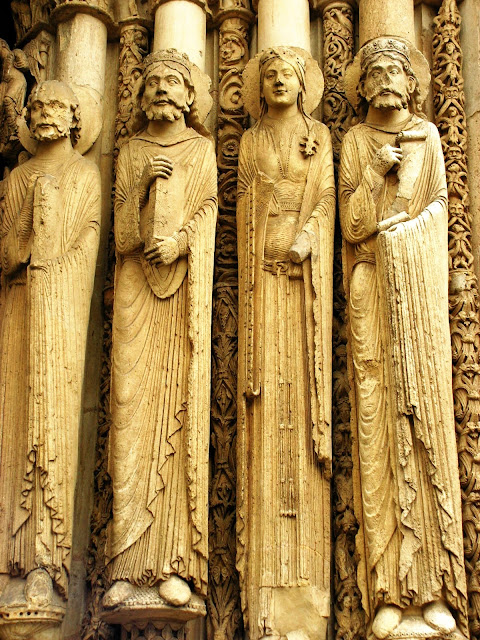 |
| Madonna of Viklau, Church of Viklau, Sweden |
Now we actually get to the body of work. I have been making under tunics for some time. Usually they end up looking like a very pared down version of an over tunic in white or other muted easy to clean color with a simple neck. I use gussets under the arms and occasionally I will add side, front, and back gores as needed by the skirt to get desired fullness. This time around I decided on just side gores and a key hole neck, even though most evidence have a much higher neck line similar to a gambison.
I have to tell you, for about five minutes I considered the possibility of the ladies at Chatres wearing gambisons under their bliauts. Warriors for God kind of a thing. Then I said it out loud. Yeah, it didn't sound right. I thought about it one more time, amused. I had mental images of the stone women hopping to life waving swords screaming "cuillier!"
How many of you are actually going to grab a dictionary to translate? (if I spelled it correctly that is.)
Alors!

The nitty gritty of making the trapunto neck and cuffs. Well, would be awesome if I could show you, but I didn't take step by steps. When I started to work on this gown, it was only with the intention of showing off the final results on Facebook. My workshop and lab was not a thought in my head at the time. I do have plans for a second more ornate, more sculptured work that I will do step by step on. Until then, you will have to endure the rambling. I cut a keyhole neck piece larger than normal, pinned to the neckline, and sewed it on so that the raw edges would be sealed between the right side of garment and wrong side of facing. Ironed to set the facing on the outside, and pinned down to prevent it from shifting while sewing channels.
Needle and thread in hand, I eyed a 1/4 inch channel around the neck hole and used a running stitch just like one would use in every day quilting. After making a channel of two, I would thread a yarn needle with a double stand of white cotton yarn to pull through the channel. Being an avid crochet enthusiast, I always have it on hand. Piercing the wrong side, I simply fed it through. A friend of mine thought herself impatient because she would stuff the channel right after she made it. Well, in researching period trapunto I found that the artist would fill the work as they went. So I can happily say that impatience is period.
On the final row I trimmed the edge down to about a little mire than 1/2 inch from the previous row of stitches. Folding the raw edge under, and clipping into the corners slightly, it was pinned and stitched down.

Repeated the process for the sleeves.
There was some conversation about how many rows should be done. What it boiled down to was counting the number of visible rows on the statue and I added one because of a small hint of a possible final row. As for the sleeves, I had seen images that showed three all the way to the elbow. I felt about five inches worth would be fine. And it was.
After all the hand work was complete with seam finishing and taking up the hem, I tried it on. I was a little concerned that the quilting would make the neck and wrists warm, but it wasn't too bad at all.
So, to my 12th century friends, I give trapunto gowns a big thumbs up.












































